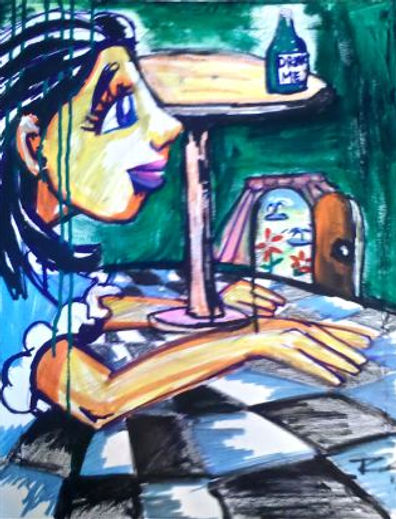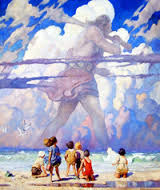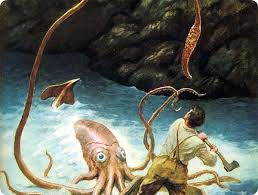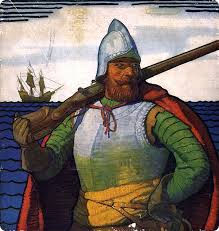SAINTANDREWSCHOOL
ARTHISTORY
The Golden Age of Illustration 1880's to 1920's
http://www.rafoxsociety.com/what-was-the-golden-age-of-illustration/
The Golden Age of Illustration was a period of unprecedented excellence in book and magazine illustration. It developed from advances in technology permitting accurate and inexpensive reproduction of art, combined with a voracious public demand for new graphic art.”What were some of the factors that determined these events in history?“The Golden Age of American Illustration,” by the publication American Artist (June, 2006) explains that “In the 1880s American illustration entered a period that is generally regarded as its Golden Age. This happened because of the convergence of a number of factors: New printing techniques were being developed, paper production was becoming cheaper, railways facilitated distribution throughout the continent, and the population was expanding and becoming wealthier as industrialization progressed. National magazines such as Harper’s Monthly, Collier’s, and Scribner’s took advantage of all these circumstances to build enormous circulations—and they needed artwork for their pages. Meanwhile, publishers of illustrated books, particularly children’s books, also found that the new techniques and new markets could make their enterprises highly profitable.Although magazines had been in business since before the Civil War, the illustrations they used had always been reproduced by hand-carving the artist’s work into woodblocks and printing it in black-and-white line. However, in the 1880s a halftone process became available that allowed for the direct reproduction of the artist’s work in all its nuances. By 1900 full-color reproduction techniques became refined enough to allow magazines to print at least the cover in color and book publishers to print a colored frontispiece. Because photography was still in its infancy and color photography unknown, there was a huge demand for illustrators.
ARTIST:
N.C. Wyeth
One of the most successful illustrators of all time, Newell Convers Wyeth studied under Howard Pyle between 1902-1904 in Chadds Ford. Perhaps more than any other student, he took Pyle's dictates completely to heart. He is the preeminent example of the results of Pyle's teachings, following every precept religiously. During his career, Wyeth painted nearly 4,000 illustrations for many magazines and books. An early aficionado of Pyle's, Wyeth became his greatest advocate even settling his family in the Brandywine area, where many of them still live today.Much of NC Wyeth's art embraced an American Western theme, filled with cowboys and Native americans, gun fighters and gold miners. He also illustrated popular children's books with pirates, knights, and brigands, includingTreasure Island and Tom Sawyer, establishing visual images of these characters in young readers' minds eyes for generations. Beside his many illustration plaudits, NC Wyeth is famous for being the father of artist Andrew Wyeth and the grandfather of artist Jamie Wyeth - a patrimony of major consequence for American art history.
http://www.americanillustration.org/artists/wyeth_nc/wyeth.html
ARTIST WORK:
ABOUT YOUR ASSIGNMENT:
You will create an illustration based on a page from a book of Your choice. It will be like you becoming the illustrator of the book. Using the following guidelines:- Identify characters, setting, and tone of a page of text.- Identify adjectives, verbs, and adverbs within text.- Use basic shape construction to draw characters. Utilize as many of the Elements of Design as possible in your work.
MATERIALS:
A page from a book you would like to make an illustration for, 4 different colored highlighters, water color paints, 9"x12" white paper and any other mediums you would like to use to create your illustration and a sheet of tag board.
INSTRUCTIONS / PROCEDURE:
http://www.theartofed.com/2012/06/11/teach-your-students-to-paint-like-an-impressionist/
1. Find a page from a book (that is not illustrated} and make several copies.
Create an illustration that is inspired by an critical action point in your story. The image can be a portrait, an interaction, a place, and/or objects.
2.Research the visual information you need to make your illustration represent the time in which the story took place.
A. Close your eyes and visualize the scene in your mind. Write down what you see
B. List the details to be included in the scene: (objects, background, buildings, people, clothing details)
C. Make thumbnail sketches of ideas, people, objects, places that you think you might want to use in a illustration. These can be simple shapes and stick figures. They will give you a guide to research the visual information for the final drawings.
3. Choose your strongest ideas and make a sketch on 9" x 12" Keep it simple and bold.
4. Make a careful line drawing of your shapes.
5. Add details using textures and shading.
6. Use shading, color blending and rich color application.
7. Emphasize important lines by making them thicker and darker.
8. If needed add a background to your illustration. (optional)
9. Be sure you have a focal point.
10. Type the page you used for your illustration on a word document, make the font as large as you can to fit on one page. Make it look like a page out of a book (add page numer ect.)
11. Glue the typed "book" page onto a piece of construction paper.
12. Glue the illustration and typed page onto a piece of 14" x 29" tag board.
13. Write a 250 word description of your work, why did you choose this era, what was most difficult about completing the project, what was most enjoyable about working on the project, in what ways does your project fit into the era you chose. Type your paper in "Arial font 14", Give your work a title,
EXAMPLE:




